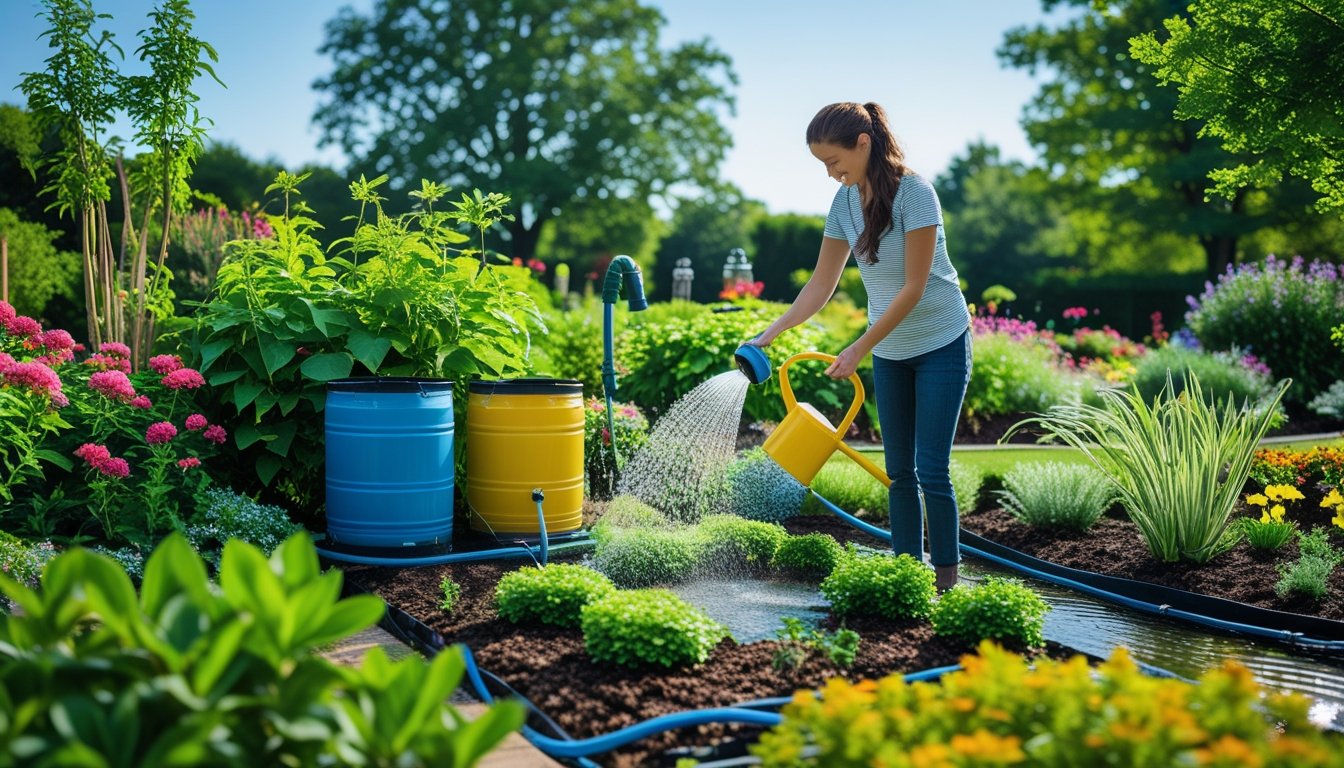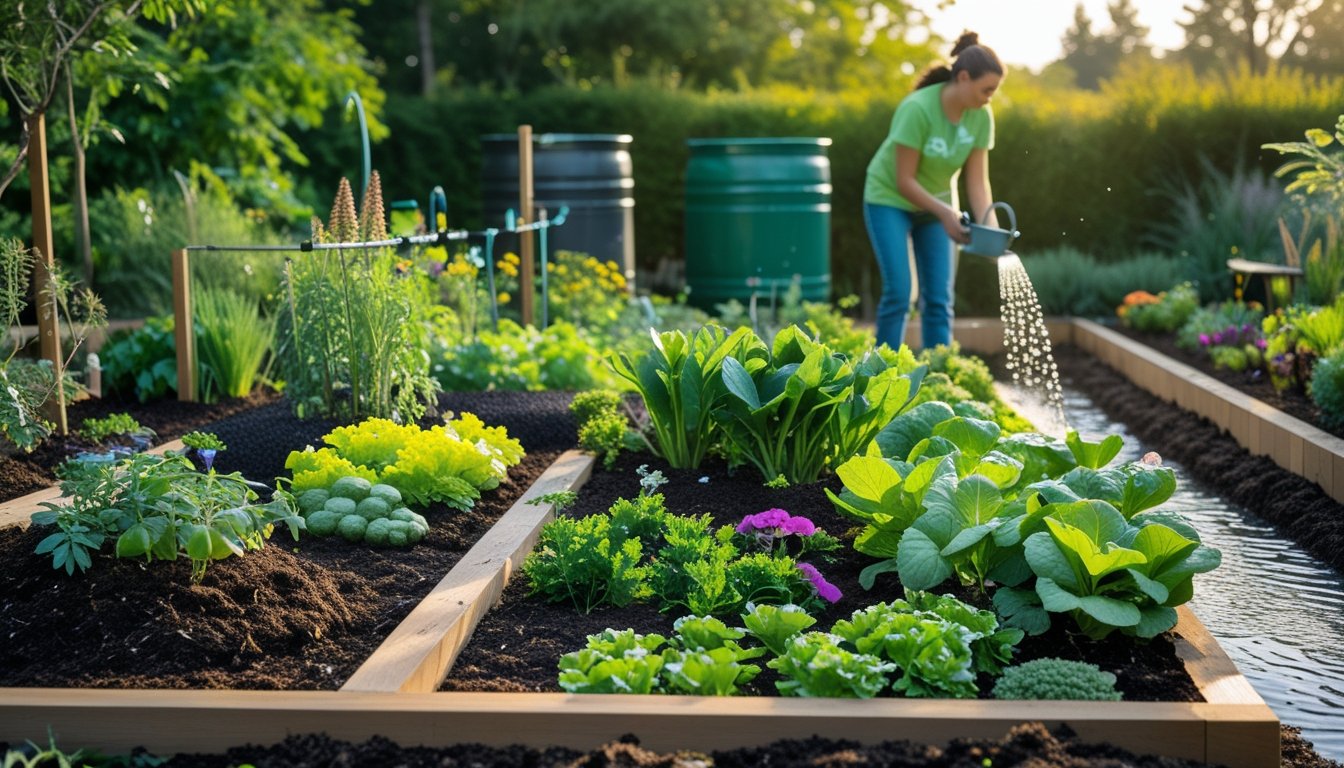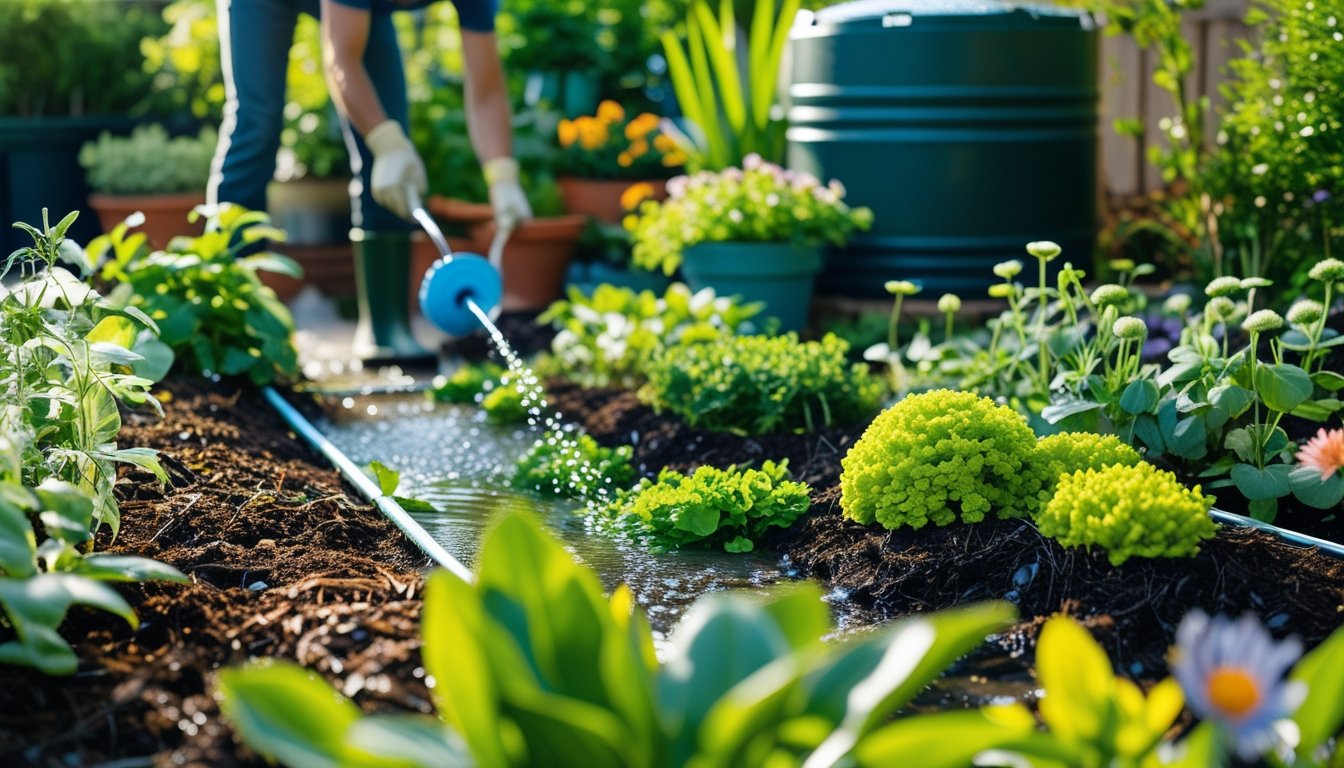Late updated: 30 Aug 2025 15:08
Written by: Sarah Hollister
Eco-Friendly Ways To Save Water In The Garden: Practical Tips
Water conservation in our gardens is more important than ever as we experience increasingly irregular weather patterns and rising utility costs. Embracing eco-friendly watering techniques does not mean sacrificing the beauty and health of our plants. Rather, it allows us to cultivate gardens that are both thriving and sustainable. A water-wise garden ensures that we save precious resources and reduce our water bills while maintaining vibrant greenery.

The misconception that conserving water means resorting to dry, barren landscapes is widespread. In reality, there are various methods to optimise water use without compromising the aesthetic appeal or functionality of our garden spaces. Simple changes like adjusting our watering schedules, selecting drought-resistant plants, and enhancing soil quality can make a dramatic difference.
These techniques not only support a sustainable lifestyle but also contribute to the well-being of our local environment. We can create lush, green spaces that are still responsive to the challenges of water scarcity. Let’s explore practical ways to achieve an eco-friendly garden that thrives through smart water use.
Key Takeaways
- Explore techniques to conserve water while keeping gardens vibrant.
- Implementing drought-resistant plants can enhance garden sustainability.
- Efficient watering and soil practices are key to eco-friendly gardening.
Fundamental Water-Saving Techniques for Eco-Friendly Gardens
Effective water-saving techniques are essential for creating eco-friendly gardens. Key methods include rainwater collection, efficient irrigation systems, optimised watering schedules, and the use of greywater. Each approach not only conserves this vital resource but also enhances garden resilience and sustainability.
Rainwater Harvesting with Barrels
Collecting rainwater is a straightforward and efficient method to reduce water use in gardening. By installing a rain barrel under your downspouts, we capture rainwater directly from our roofs. This stored rainwater can then be utilised during dry spells, providing our plants with a natural water source.
It's important to ensure that barrels are covered to prevent debris and mosquitoes. Regular cleaning helps maintain water quality. Using rain barrels is a cost-effective way to conserve water while reducing our reliance on municipal water supplies.
Drip Irrigation Systems and Efficient Watering
Drip irrigation systems offer a highly efficient method for maintaining garden hydration. These systems use emitters to deliver water directly to the root zones of plants, minimising waste. Drip irrigation reduces evaporation and runoff, making it an eco-friendly choice.
We can tailor our systems by spacing emitters according to plant needs. Regular checks prevent clogs and ensure effective operation. Implementing drip irrigation helps us conserve water while ensuring our plants receive adequate moisture.
Smart Watering Schedules and Timing
Establishing smart watering schedules helps optimise water use by aligning irrigation with plant requirements and natural rainfall. We should water our gardens early in the morning or late in the evening to minimise evaporation.
Using smart irrigation controllers enables us to adjust watering duration based on weather patterns, ensuring efficient water use. These controllers integrate weather data to fine-tune irrigation. This proactive approach not only conserves water but also promotes healthier garden growth.
Greywater Systems and Recycled Water Usage
Implementing greywater systems allows us to reuse household water for irrigation purposes. These systems divert water from sinks and showers, filtering it for safe garden use. By recycling water, we reduce the strain on potable water resources and minimise waste.
It's crucial to use biodegradable soaps to prevent harmful chemicals from entering the garden. Regular maintenance ensures system efficiency and safety. Greywater systems represent a sustainable approach to water conservation, turning everyday waste into a valuable resource for our gardens.
Sustainable Garden Design and Soil Practices for Water Conservation

Optimising water use in gardens involves strategic plant selection, using soil amendments like organic mulch and compost, and designing layouts that maximise water efficiency. Let's explore how selecting the right plants, using mulching techniques, and smart garden designs, among other practices, can help us conserve water.
Choosing Native and Drought-Tolerant Plants
To create a water-wise garden, selecting native plants and drought-tolerant plants is a wise choice. These plants, well-suited to local climates, typically require less water and maintenance, making them ideal for sustainable gardening. Their deep root systems help in absorbing water more effectively.
Native plants also attract pollinators, enhancing biodiversity. Incorporating a mix of wildflowers, grasses, and shrubs can beautify the landscape while being practical. These hardy species are an excellent fit for xeriscaping and low-maintenance gardens.
Mulching and Organic Mulches
Mulching is an essential practice for retaining soil moisture. Covering the soil with organic mulches like straw, compost, or wood chips helps reduce evaporation and suppress weeds. This technique not only conserves water but also improves soil structure as organic matter breaks down.
Using locally sourced organic mulch can also contribute to the eco-friendly garden approach. As it decomposes, the mulch enriches the soil with nutrients. This simple yet effective practice supports healthy plants and maximises water efficiency.
Garden Layout and Hydrozoning
Designing a garden with water conservation in mind involves strategic planning, such as hydrozoning. By grouping plants based on similar water needs, we ensure that water is used efficiently and isn't wasted.
Implementing rain gardens in low-lying areas can help direct and utilise runoff water. By prioritising areas that naturally collect water, we can create specific zones that support deeper root systems and improve plant health. This structured layout leads to a more sustainable and water-wise garden.
Improving Soil Moisture with Compost
Incorporating compost into our gardening routine helps in retaining soil moisture. Rich in organic matter, compost enhances soil moisture levels, ensuring that less frequent watering is required. The added nutrients from compost offer multiple benefits, supporting robust plant growth.
Additionally, using compost tea or liquid fertiliser can aid in strengthening root systems and improving plant resilience. These amendments enhance soil health, making it more receptive to water. Embracing compost as part of our garden maintenance practice leads to visible improvements in water conservation efforts.
Frequently Asked Questions

In our exploration of eco-friendly water-saving techniques for gardens, we'll address common queries about effective watering strategies, plant selection, and other sustainable practices.
What are effective watering techniques to reduce water consumption in gardens?
Efficient watering methods play a crucial role in conservation. For instance, watering plants early in the morning or later in the evening can minimise evaporation. Additionally, focusing water directly at the root zone can significantly decrease waste, ensuring that plants receive the moisture they need without excess runoff.
How can mulching contribute to water conservation in gardening?
Mulching acts as a protective layer that retains soil moisture, reduces evaporation, and moderates soil temperature. Materials such as wood chips, straw, or compost not only aid in water retention but also improve soil health. By preventing water loss, mulching is an invaluable practice in a water-efficient garden.
In what ways can rainwater harvesting be implemented to manage garden irrigation?
Rainwater harvesting involves collecting and storing rainwater for garden use. From simple rain barrels placed under downspouts to more elaborate collection systems, capturing rainwater can drastically cut reliance on mains water. This natural supply can then be efficiently used to irrigate plants, especially during dry spells.
What role does plant selection play in creating a water-efficient garden?
Choosing drought-tolerant plants makes a significant difference in water usage. Native plants often require less water and maintenance, adapting well to local climates. By selecting varieties that thrive with minimal irrigation, we can cultivate gardens that are both beautiful and sustainable.
How does drip irrigation compare to traditional watering methods in terms of water conservation?
Drip irrigation delivers water directly to plant roots through a network of tubes and emitters, reducing waste and evaporation. Unlike traditional sprinklers that disperse water over a large area, drip systems are precise and conserve water by only targeting necessary areas, making them a superior choice for efficient garden management.
What are the benefits of creating a drought-resistant garden, and how can it be achieved?
Drought-resistant gardens not only conserve water but also flourish in dry conditions, reducing dependency on frequent watering. Achieving this involves selecting resilient plant species, effective mulching, and utilising efficient watering systems. These gardens demonstrate that lush, thriving landscapes are possible without excessive water use.
